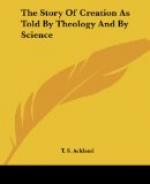The Geological records harmonize exactly with the Bible as to the date of man’s appearance on the earth. It is towards the close of the age of gigantic mammalia, that the earliest remains of man’s workmanship make their appearance in the shape of tools and weapons rudely fashioned from stone. Parts of human skeletons have also been occasionally found, but they are exceedingly rare. Weapons and bones are alike confined to superficial, and comparatively very recent formations. From such traces as have been found there is no reason to believe that any physical changes of importance have taken place in man’s body since his first appearance on the earth. The differences which do exist are of the same kind as, and not greater than, the differences which exist between individuals at present.
The gift of dominion over the lower animals seems to indicate something different from that which gives one animal superiority over another, and accordingly we find that it is not by physical power that that dominion is exercised; but that in most of his physical faculties man is inferior to the very animals which he holds in subjection. It is partly in virtue of his intellectual superiority, and partly perhaps by means of an instinctive recognition on the part of the animals of man’s higher nature (Gen. ix. 2) that that supremacy is maintained.
Section 10. Development.
We have now to consider the question of development, in reference to the Mosaic Record of the last two days, and to the known facts to which that record has relation. The account of the third day’s work has also a bearing on the subject, but as the same considerations will to a great extent apply to animals and to plants, it will not be necessary to make any special reference to it.
The facts in favour of the theory of development are these:—1. The different classes of plants and animals are not separated by broad lines of demarcation, but shade insensibly into each other. 2. The characteristics of the same species are not constant; the lion, for instance, the horse, the elephant, and the hyena of the present day differ in many minor points from the corresponding animals of the Tertiary period, so that unless there was a possibility of spontaneous change, we must assume successive creations of animals, with only trivial differences. 3. In all animals there are minute individual differences, and if under any circumstances these differences had a tendency to accumulate, they might in the course of time result in great structural modifications. 4. Man has been able to take advantage of this fact and by careful selection to mould the breeds of domestic animals to a certain extent in accordance with his own wishes.
The theory of development assumes that for the care of man other forces might be substituted, which in a long course of ages might result in changes of far greater extent than those produced by human agency. The forces assigned are natural selection and sexual selection. The difficulties in the way of this hypothesis have been already considered, and only require to be briefly re-stated.




